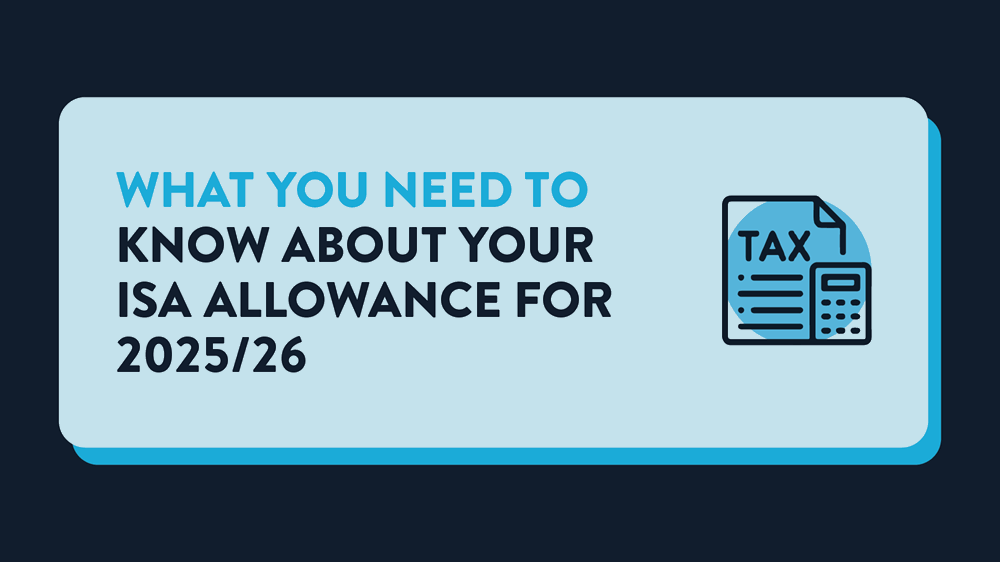Wealthify currently offer Stocks and Shares ISAs (also known as Investment ISAs), Cash ISAs, and Junior Stocks and Shares ISAs, but in this blog, we’ll explain all the types of ISAs on offer and the tax-free allowances for each.
As of April 6th 2024, the UK Government implemented some new ISA rules which have rolled into the 2025/26 tax year. And as these changes could potentially affect the way you approach your money management, Wealthify breaks down the need-to-knows of your ISA allowance for 2025/26.
- What is an ISA allowance?
- What is the ISA allowance for 2025/26?
- When does the ISA allowance reset?
- Can you use previous years ISA allowances?
- ISA Historic Allowances
- What happens if you go over your allowance?
- Does ISA transfer count towards allowance?
- How to transfer your ISA
- Can I split my allowance between different providers?
- What are the different types of ISAs?
- How to check my ISA allowance
What is an ISA allowance?
From savvy savers to intrepid investors, no matter how skilled you are with your pennies and pounds, there’s something about an ‘ISA allowance’ that makes a lot of people pause to scratch their heads.
Part of Wealthify’s DNA is to debunk jargon and ensure there’s clarity around financial terminology and concepts. And ISAs are an example of this, they’re just...not that self-explanatory, are they?
1. ‘Individual Savings Accounts’ (also known as ISAs) are the government’s way of helping your money grow in a tax-friendly way.
2. But the amount you can put into an ISA in a year (from April 6th to April 5th) is limited; depending on which type of ISA you’re using and what its respective ISA allowance is.
3. The main takeaway to remember is that you’re allowed to save up to the ISA allowance over the tax year, and any gains you make during that time are tax-free! (In general savings or investment accounts, you'll likely need to pay capital gains tax or income tax after a certain amount.)
Your tax treatment will depend on your individual circumstances, and it may be subject to change in the future.
What is the ISA allowance for 2025/26?
As things currently stand, your annual ISA allowance for the 2025/26 tax year is set at £20,000 (although this amount is subject to change each year, the government has said this will be fixed until 2030).
* There’s a certain type of ISA called a Lifetime ISA that many people use to save for their first home deposit or as a personal pension pot. And this type of ISA is capped at saving £4,000 per tax year. But that doesn’t mean you lose out — you can still use your remaining £16,000 allowance across the other types of ISAs to continue saving/investing your money.
** Help to Buy ISAs are no longer available to open, but we’ve included this information in case you already have one. The Help to Buy ISAs are limited to £200 per month deposits — totalling £2,400 per tax year — however, you could still use the remaining £17,600 allowance (£20,000 total) in another type of ISA as outlined above.
† Many people who are saving for their children can take advantage of a £9,000 annual tax-free allowance (per child) by using a Junior ISA, freeing up the parent or guardian’s personal ISA allowance.
With investing your capital is at risk. Your child could get back less than invested.
When does ISA allowance reset?
You have up until 11:59pm on April 5th 2026 to make the most of your current ISA allowance — otherwise you’ll lose it forever as you’re not allowed to carry unused allowances over at the end of the tax year.
When the clock strikes midnight and it becomes April 6th, the new 2026/27 tax year will begin, and your allowance will reset to £20,000.
Can you use previous years ISA allowances?
Unfortunately, not! As soon as we enter the new tax year on April 6th (like a somewhat less exciting version of New Years) the window to use your previous tax-free allowance closes, too. (Sad party blower sound.)
So, most people try to pay as much as they can into an ISA during the current tax year, as they can’t carry the £20,000 allowance over.
That’s not to say you need to open a new type of ISA just because it’s the new tax year though. A common misunderstanding about ISAs is that you can keep an existing ISA open without having to do anything to get your new £20,000 tax-free allowance. It simply resets on April 6th!
In fact, the more money you hold in an ISA, the more the interest/gains are compounding. So, consolidating your money into one ISA is considered a sensible option for maximising your gains.
ISA Historic Allowances
ISAs were introduced back in 1999, and this may come as a surprise to you, but the annual allowance hasn’t always been £20,000. In fact, it used to be a lot less.
For the 1999/00 tax year, the ISA allowance was set at £7,000, but you could only put up to £3,000 in a Cash ISA. Then in 2008/09, the annual allowance increased by £200 (bringing it to £7,200), although it went up by £200 (to £3,600) for Cash ISAs.
But the real push was felt in 2014/15 when the government decided to increase the ISA allowance to £15,000 a year.
The other big boost happened in 2017/18 when the annual allowance rose to £20,000 for the first time, making it possible for savers and investors to considerably increase their contributions. The ISA allowance amount has remained the same ever since, though it could be subject to change in 2030.
What happens if you go over your ISA allowance?
It’s your responsibility to keep track of your ISA allowance and how much of it you’ve used.
If you’ve accidentally paid too much into your ISA (or ISAs if you have multiple), you won’t receive any tax relief on the excess payments you’ve made. You can speak to your ISA provider if you’re unsure.
Don’t worry though, if you do exceed your ISA allowance, you can contact HMRC to let them know. Or, if it happens without you realising, HMRC will contact you after the end of the tax year to let you know what you need to do to correct this mistake.
Remember; the allowance is only applicable to the amount of money you deposit into ISAs during the tax year (you’re not capped at £20,000 for your deposits + the gains).
Does ISA transfer count towards allowance?
If you’re wondering whether transferring your ISA would mean losing your allowance – there’s a simple way to avoid this. You can transfer your funds from multiple ISAs into one, but it’s best to use the provider’s ISA transfer procedure to do this (like Wealthify offers). By transferring an ISA balance via the transfer form, that money retains its tax benefits.
For example, if you simply withdrew your money from one provider’s ISA and then deposited it into a new provider’s ISA, you’d potentially ‘use up’ your allowance in the process. At Wealthify, we always prefer our customers to use our ISA transfer form in order to keep their allowance and retain their tax benefits.
Rest assured; if you do decide to transfer between ISAs, your current tax year’s allowance isn’t affected by what you deposited into an ISA during any previous tax year.
How to transfer your ISA
With online investment platforms, like Wealthify, transferring your ISA has never been easier!
Tell us how much you’re transferring, how long you’re planning to invest for, and how much risk you’d like to take. We’ll then send you a transfer form to sign and send back to us as soon as possible. After that, our dedicated Customer Care Team will sort everything out for you and tell you when it’s done!
For every ISA transfer, please make sure you always use the official transfer form. Once transferred, we’ll look after your ISA and make sure your money is working as hard as you do.
Can I split my ISA allowance between two providers?
Under the new ISA rules, yes. You’re still responsible for tracking how much you’ve deposited across all of your ISAs and for ensuring you haven’t gone over your £20,000 allowance between April 6th–April 5th; but you can open as many ISAs as you’d like to across different providers (aside from a Lifetime ISA as you’re only allowed one).
And it’s worth remembering that Junior ISAs are limited to one type per child; for example, they could have one Junior Cash ISA and one Junior Stocks and Shares ISA with a combined allowance of £9,000 per tax year.
Previously, the rules meant you could only open one of each type of ISA in any tax year.
What are the different types of ISAs?
In total, there are four main types of ISAs for adults:
- Cash ISAs;
- Stocks and Shares ISAs (also called Investment ISAs);
- Lifetime ISAs;
- And Innovative Finances ISAs.
(We mentioned Junior ISAs for children under 18 earlier for any parents and guardians who are keen to keep their own ISA allowance in full. For more information, please read our Junior ISA allowance article.)
How to check my ISA allowance
Since the new ISA rules changed in 2024, allowing you to open multiple types of ISAs with as many providers as you’d like, you may need to pay closer attention to your allowance if you’re spreading your money out.
During each tax year, you can pay into as many of each type as you’d like to, within the limits of your £20,000 per tax year ISA allowance. Just remember, you need to keep track of how much you’ve used.
For example, you can either put the whole £20,000 in one type of ISA or split it between the different types of ISAs (noting the £4,000 cap on Lifetime ISAs) — the choice is up to you.
With Wealthify’s investment app, you can easily check your remaining Stocks and Shares ISA allowance whenever you want.
This is in addition to our many other benefits — simple investing at a risk level to suit your individual comfort level, Personal Pensions, a competitive savings account (powered by ClearBank), and access to market updates from our expert Investment Team. With investing, your capital is at risk.
The tax treatment depends on your individual circumstances and may be subject to change in the future.
Please remember that with investing, the value of your investments can go down as well as up, and you could get back less than invested.
Wealthify does not offer financial advice. Please seek financial advice if you're unsure about investing.
Resources:
https://www.gov.uk/individual-savings-accounts/
https://www.moneyhelper.org.uk/en/savings/types-of-savings/a-guide-to-help-to-buy-isas



